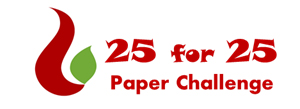|
Last year, for the first time, paper consumption decreased. In fact, it decreased by over 10%, which was a testament to the hard work of a lot of dedicated people across the campus. But if we could achieve a 10% goal last year, why not try a 25% goal this year in celebration of HKUST's 25th anniversary?
Already the School of Engineering (SENG) has jumped off to a great start. In the first six months of this academic year, SENG reduced its paper consumption by 21%
We know that a 25% reduction for the university is an aggressive goal, but if we are successful, we will:
- Reduce paper by 10,000 reams (that is 5 million sheets of paper!)
- Save 600 trees
- Save over 1.9 million liters of water
- Save nearly $250,000 for the university
The Research Administration (RA) team of the Research Office is a great example of how this can be done. By implementing a new policy to eliminate paper from several of their procedures, they feel they will see a dramatic reduction in their paper consumption.
Mrs Jenny Cheng from RA shared that as an office with one of the heaviest demands for paper for day-to-day administration, it has long been their goal to reduce paper waste. After a thorough review of current practices and due consideration of the impact on various parties, RA decided to go paperless as of 1 January 2016. Most paperwork from the office will now be delivered via email with scanned documents.
Mrs Cheng notes, "The benefits of this initiative are twofold. Not only will it reduce paper waste and help preserve the environment, it will also help transform our tedious administrative procedures into a more dynamic interaction with various parties of the University. In this era of information technology, we trust that this initiative will be warmly received by the members of HKUST. We expect that not only streamlining the administrative procedures, the new policy will also enable us to deliver important information to our faculty members/researchers in an efficient manner and help prepare the office for electronic document management in the future. We are confident that our faculty/staff members will find this new initiative effective and environmentally friendly. We urge other units of the University to also go paperless and experience its benefits."
With RA's success, we are inspired that others can do this as well. To get started, consider some of these simple measures that can lead to big improvements.
Easy tips to print less
- Go email paperless. Think twice before printing out an email. Do you really need a hard copy? Emails can be saved and filed just like documents, and are much easier to find later. Once you eliminate printing e-mails, you'll be glad you did.
- Change your default print settings to double-sided printing (also called duplex printing). Many office printers and copiers already do this, but if not, ITSC can help set it up.
- Change your default document setting to use wider margins or single-line spacing. For MacBook users, to change your default, you can click "Format" on the top of MS Word window, and then click "Document" to change your default margin. To change your spacing, click "Paragraph" under "Format". For Window users, to change Word's default page margins, click on the "Page Layout" tab and click the "Page Setup" dialog box button, change your desired default margin, and then click "Set As Default". To change default spacing, click on the "Paragraph" tab and choose single-line spacing, and click "Set As Default" as well.
- Try using scrap paper for printing less important documents. Lots of paper is only used on one side, which means that the other side is perfectly good. Try allocating one shared departmental printer for using scrap paper to avoid confusion.
- Merge PDFs using "Preview" application to print it in one printing job (for MacBook users). MacBook users can open several documents using preview under one window, so when you print, you end up with a longer double-sided document instead of lots of one pagers.
- Preview documents before printing to avoid re-printing. Isn't it annoying to hit the print button and then see that the wrong pages popped out of the printer? (It happens to all of us.) You would not believe how much scrap paper is generated by hitting the print button before double-checking.
- Transfer documents electronically within departments instead of using hard copies. We understand that communication among different departments is sometimes difficult without hard copies, but we hope the habit of using electronic documents will become easier with practice.
- Try avoiding printed agendas for meetings. Agendas are only used once, and often tossed right after the meeting. Why not send it ahead of time electronically, and then use a PPT slide with the agenda information?
 |

|
 |
|